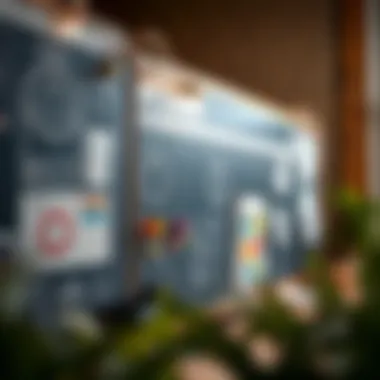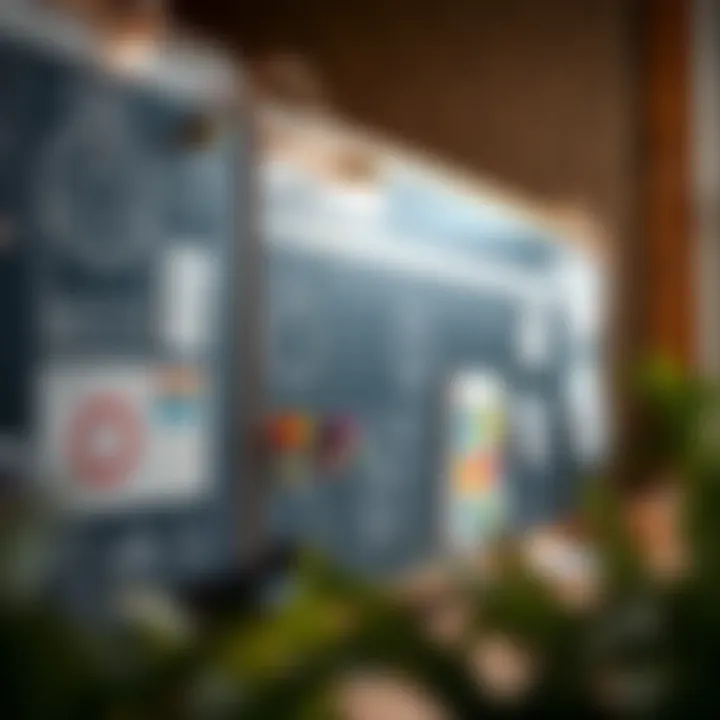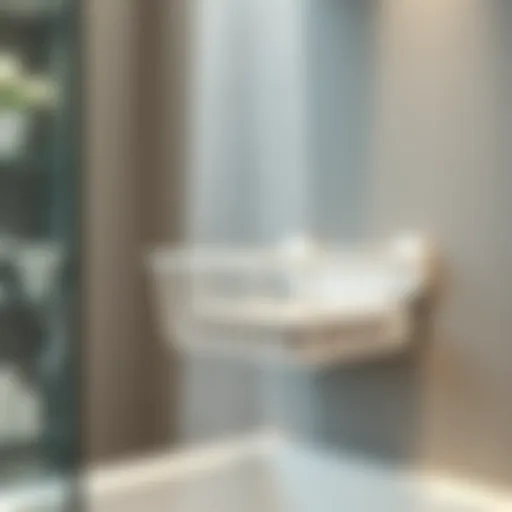Maximizing Efficiency with Magnetic Task Boards


Intro
In today’s fast-paced world, keeping things organized can feel like trying to herd cats. Enter magnetic task boards—these nifty tools not only display important reminders but also lend a hand in boosting productivity and creativity. From homes to bustling offices, magnetic task boards present numerous ways to stay organized. This article dives headfirst into their versatile nature, illustrating how they can seamlessly blend into various styles and settings.
Furniture Trends and Styles
As the design world evolves, so too does the perception of functional items like magnetic task boards. They are no longer mere organizational tools; they have become a statement piece in modern interiors.
Current Trends in Furniture Design
Today’s furniture scene is characterized by a blend of minimalism and functionality. Key trends include:
- Sustainable Materials: The focus on eco-friendly materials is shaping furniture design. Bamboo and recycled metals aren’t just buzzwords; they symbolize a larger movement towards sustainability.
- Flexible Spaces: With remote work becoming a norm, furniture that adapts to various needs is gaining traction. Magnetic task boards can fit in with foldable desks or modular seating.
- Bold Colors and Patterns: Surprising hues and intricate patterns are making their way into contemporary designs, pushing the envelope of traditional styles.
Popular Furniture Styles and Their Characteristics
Different styles of furniture pair well with magnetic task boards, catering to diverse tastes:
- Scandinavian: Clean lines and functionality define this style; magnetic boards with minimalistic designs resonate well here.
- Industrial: Raw materials and an urban flair characterize industrial design. A magnet board made from reclaimed wood can enhance the overall aesthetic.
- Mid-Century Modern: Celebrating retro vibes, this style offers unique shapes and forms. A magnetic board with retro graphics can harmonize beautifully.
Buying and Maintenance Guides
Understanding how to choose and care for your magnetic task board can make all the difference in its longevity and effectiveness.
Essential Tips for Purchasing Magnetic Task Boards
When shopping for a magnetic task board, keep these pointers in mind:
- Size Matters: Consider where you’ll hang it. A large board may dominate a small space, while a tiny one might get lost on a big wall.
- Material Choices: Metal, cork, or fabric-covered boards each offer unique benefits. Decide which suits your style and needs best.
- Customizable Options: Look for boards you can personalize. Some come in various colors or shapes, allowing you to find the perfect fit for your decor.
Maintenance and Care for Different Materials
To keep your magnetic task board looking sharp:
- Metal boards: Wipe them down with a damp cloth to prevent rust and dust build-up.
- Fabric boards: Regular vacuuming can help refresh them, ensuring they always look their best.
- Cork boards: If magnets leave marks, a gentle sand can help smooth out the surface.
"Magnetic task boards are more than just tools; they're canvases for creativity and productivity."
In essence, integrating a magnetic task board into your life or design project is not just about functionality. It’s also about creating an environment that inspires and motivates. Keep reading to discover how these boards can play a leading role in optimizing your home or workspace!
Understanding Magnetic Task Boards
Magnetic task boards have emerged as essential tools for enhancing organization, facilitating communication, and bolstering productivity in both personal and professional spaces. Their unique characteristics allow them to adapt dynamically to various settings and uses, making them particularly valuable in today’s fast-paced world. Understanding what these boards are all about is crucial for homeowners, designers, and professionals alike who are looking to streamline processes and foster creativity.
Definition and Purpose
At their core, magnetic task boards are essentially surfaces—often metallic or coated with a magnetic material—that hold tasks, notes, reminders, or any number of items using magnets. They serve as a visual aid, bringing order to what could easily turn into chaos on a cluttered desk or wall. The purpose of a magnetic task board extends beyond mere organization; it acts as a facilitator of communication. For example, in a home office, it can serve as a centralized space for to-do lists and deadlines, enabling a clear overview of what lies ahead.
The versatility of these boards is a key selling point. You can use them to display artwork in a child's room, create a strategic planning station in a corporate office, or anything in between. The process of customization is easy and straightforward—simply swap out notes or rearrange tasks as priorities shift. This dynamic capability not only fosters flexibility but also encourages a sense of agency over one’s tasks and projects.
Historical Context
The concept of magnetic boards traces its roots back to the 20th century when metal and magnet technologies began evolving. Early versions were often rudimentary, designed primarily for industrial use, like tool organization in workshops. However, as the demand for home organization solutions grew in the latter part of the century, these boards began to find their way into residential spaces.
In the 1980s, with the rise of personal computing and the increase in home offices, the necessity for effective organizational tools was amplified. Magnetic task boards transitioned from mere utility items to stylish decor pieces, appealing to the aesthetic sensibilities of homeowners and designers alike. They evolved in functionality, incorporating options such as dry-erase surfaces and customizable designs that align with various interior styles.
Today, magnetic task boards stand at a crossroads of function and form, continuously evolving to meet consumers' needs for both organization and visual appeal. Understanding this evolution not only underscores their importance but also highlights the potential they hold for those seeking an edge in productivity and engagement.
Materials Used in Magnetic Task Boards
Understanding the materials used in magnetic task boards is essential for homeowners and designers alike. Choosing the right components not only affects the board’s durability and functionality, but also its aesthetic appeal and adaptability in various spaces. The materials determine how well the boards perform their tasks, ensuring they accommodate the diverse needs of users.
Metal Options
When it comes to metal options for magnetic task boards, there are a few standout choices that cater to different tastes and requirements. Steel is the preeminent option, prized for its strength and magnetic properties. A basic steel board can hold notes, hooks, and various attachments without bending or warping.
Aluminum, on the other hand, appeals to those who prefer a lighter option. It’s easier to install and can be just as sturdy. Many homeowners appreciate the sleek, modern look it provides, making it suitable for contemporary interiors.
For those seeking something a bit different, galvanized steel is an option worth considering. The added corrosion resistance makes it ideal for environments that may experience humidity. Each metal type brings its unique benefits. Users should weigh factors like intended use, environmental conditions, and personal style when making a choice.
Magnetic Surfaces
Magnetic surfaces matter a lot when it comes to the performance of task boards. Beyond just being metal, the type of surface can influence how well items stick. Non-porous surfaces tend to work better, allowing magnets to adhere more effectively.
Many boards come with a painted finish that enhances not only the visual appeal but also the magnetic functionality. Enamel for example, provides a smooth surface that minimizes scratches and allows for easy cleaning. That is essential in maintaining a tidy and functional workspace.
Additionally, some boards utilize a specially engineered magnetic surface designed to maximize magnet strength and reduce slippage. These options bring substantial advantages for heavy or large items that need to stay put without fuss. Choosing the right surface contributes significantly to the overall utility of the board.
Coating and Finish
One often overlooked aspect of magnetic task boards is the coating and finish. A good finish can protect the board while also enhancing its appearance. Powder coating is a popular choice, known for being durable and offering a wide range of colors. This helps integrate the board into an existing decor seamlessly.


"The right coating can not only provide protection but also add a touch of style to your space."
Another common finish is a laminate, which provides a smooth writing surface. This can be especially useful for boards used in educational or creative environments, where notes and drawings might be frequently updated.
For those concerned about sustainability, eco-friendly coatings are becoming more available. These options lessen environmental impact and could be particularly appealing to eco-conscious homeowners or businesses. Coating and finish not only plays a role in durability but also in how well the board blends into its environment, making it a key consideration for effective usage.
Types of Magnetic Task Boards
Understanding the various types of magnetic task boards is essential for maximizing their potential in both home and workplace environments. Each type serves unique purposes and comes with its own set of advantages and design considerations.
Wall-Mounted Boards
Wall-mounted magnetic task boards are a staple in both office and home settings. These boards serve as efficient visual communication hubs, ideal for anyone looking to streamline their organizational efforts. They can transform a blank wall into a vital tool for planning and collaboration.
Benefits:
- Space-Saver: Wall-mounted boards use vertical space, making them ideal for smaller areas.
- Visibility: Items placed on these boards are in plain sight, reducing the risk of forgetting tasks or deadlines.
- Aesthetic Appeal: They come in various designs and colors, allowing for customization that fits in with the decor of any room, whether it's a sleek office or a cozy kitchen nook.
One example is a wall-mounted board that features both a magnetic surface and a corkboard section. This versatility allows users to pin documents and attach notes using magnets, making it a dual-purpose organizer. Such boards are suitable for busy families or project teams who need to keep various threads of information accessible.
Portable Boards
Portable magnetic task boards are a flexible choice for those who are frequently on the go or work in multiple settings. Ranging from small, handheld options to larger, foldable models, these boards offer convenience without sacrificing functionality.
Benefits:
- Flexibility: Users can easily transport these boards to different locations, whether it’s home, office, or off-site meetings.
- Collaboration: Perfect for brainstorming sessions or impromptu meetings, portable boards can foster teamwork wherever they are set up.
- Compact Design: Many portable boards fold up for easy storage, making them a practical choice for limited spaces.
Consider a portable board that doubles as an easel. These options not only allow writing and attaching magnets but also enable presentations in a pinch. For DIY enthusiasts, a portable board can become an inspiring canvas for creative projects anywhere.
Integrated Solutions
Integrated solutions combine magnetic task boards with other functional aspects, such as shelving, lighting, or electronic displays. These multifaceted boards appeal to those who seek a one-stop organization solution.
Benefits:
- Comprehensive Functionality: Integrated boards do more than hold papers; they can also serve as storage spaces or digital displays.
- Space Efficiency: Combining several tools into one unit means less clutter and a more efficient use of limited space.
- Enhanced Interactivity: Some integrated boards include features such as whiteboard surfaces or smart technology that connects to apps, promoting a modern approach to organization.
Imagine a magnetic task board equipped with LED lighting and built-in digital reminders. Such solutions not only enhance visibility but also integrate modern tech to easily manage tasks and schedules. This innovation caters particularly well to those in fast-paced work environments or creative roles, offering a streamlined approach to daily organization.
"Magnetic task boards are an excellent way to blend style with functional design, reinforcing the idea that organization can also be a form of art."
Benefits of Using Magnetic Task Boards
When you dive into the world of magnetic task boards, it’s not just about slapping a magnet on a metal surface; it’s about unlocking a treasure trove of efficiency and creativity. These boards provide a palette for organizing thoughts, projects, and tasks in a way that resonates with the user’s style and needs. The advantages they bring to both home and office environments are significant, making them a valuable tool that deserves a closer look.
Enhanced Organization
Picture this: a bustling home office scattered with sticky notes, papers, and to-do lists that seem to multiply overnight. It can be chaos, right? Enter the magnetic task board. Having a designated space to display tasks, important notes, and reminders not only declutters a workspace but also helps keep everything in one glance. It’s almost like having a personal assistant, always ready to remind you of what’s next on your agenda.
Moreover, magnetic boards encourage prioritization. You can color-code tasks based on urgency or category. For instance, blue magnets for ongoing projects and red magnets for high-priority tasks. This system creates a visual hierarchy that is intuitive, allowing even the busiest bee to navigate through their responsibilities effortlessly.
In homes, parents can have a dedicated task board for family activities, school reminders, and chores, ensuring everyone is on the same page. The potential for enhanced organization extends to DIY enthusiasts, who can display schedules and crafting ideas, transforming chaos into a masterpiece.
Visual Communication
In any setting—be it a family home or a collaborative workspace—the exchange of information can become muddled. This is where visual communication shines through with magnetic task boards. By presenting information visually, it’s easier for individuals to grasp concepts quickly, ensuring no detail gets lost in translation. Think about it: a project update conveyed through bright visuals and concise notes can be more effective than a lengthy email.
Not only does this method of communication cater to different learning styles, but it also fosters engagement and collaboration. In team settings, members can pin up ideas or feedback directly on the board, stimulating discussion. The simple act of moving a magnet can signify approval or progress, reminding us all of the shared goals and responsibilities.
Using magnetic boards for visual communication can also enhance creativity. Brainstorming sessions become more dynamic; ideas can be arranged, rearranged, and cycled through effortlessly. It allows for a more interactive way to present concepts, which is very helpful in design and marketing strategies. Simply put, these boards transform a static communication method into a lively dialogue.
Flexibility and Customization
One of the standout attributes of magnetic task boards is the flexibility they offer. Whether you’re looking to instill a bit of flavor into your workspace or create a functional family hub, magnetic boards can be tailored to fit diverse needs. From large wall-mounted boards in offices to portable versions for on-the-go planning, the adaptability is impressive.
Customization options are nearly endless. Users can choose from a variety of colors, sizes, and layouts. Magnetic task boards can be designed to match any aesthetic, making them a delightful addition to any space. Want a modern sleek finish? There’s an option. Prefer something a bit more rustic? You can find that too. This level of personalization ensures the board doesn’t just serve a function but also complements the aesthetics of the room.
Additionally, magnetic boards can quickly adapt to changing tasks or goals. If a particular project wraps up, it could be as simple as removing the magnets and replacing them with new priorities. This fluidity in task management promotes a proactive approach to organization, which can be a breath of fresh air in both work and home environments.
"The versatility of magnetic task boards lies in their ability to transform spaces with elegance and practicality, bringing order out of chaos through visual interaction."
Design Considerations
When it comes to integrating magnetic task boards into your living space or workplace, the design considerations are pivotal. The aesthetics and functionality of these boards can significantly affect how they blend with surroundings while enhancing productivity. Understanding these elements helps in selecting a board that not only serves its purpose but also adds to the environment's visual appeal.
Colors and Aesthetics
Choosing the right colors for your magnetic task board can be a game changer. Colors have a profound impact on mood and productivity. For instance, a soft pastel palette can create a calming effect, making it ideal for home offices or study areas. Bright colors, on the other hand, may spark creativity and energy, which can be beneficial in collaborative workspaces.
In addition to color schemes, the overall aesthetics of the board should not be underestimated. A sleek, modern design can enhance a contemporary office, while a more rustic appearance might suit a cozy, home-like environment. For maximum flexibility, many boards come with customizable finishes that can match your furniture or decor. Consider the materials as well; a cork board with a magnetic surface can offer a blend of warmth and functionality, attracting those who favor a natural look.


"Design is not just what it looks like and feels like. Design is how it works." - Steve Jobs
Aesthetically pleasing boards can also serve as conversation starters, making them not only functional but also an attractive element of interior design. Think about integrating patterns or images that resonate with you or your team. You could even create a collage of inspiring quotes or artwork on the board, offering a sense of personal connection to the workspace.
Size and Scale
The size and scale of your magnetic task board must align with the available space and intended use. A large board might dominate a small room, rendering it overwhelming, while a tiny board in a spacious office could easily go unnoticed. It's essential to strike a balance that ensures the board is practical and appropriately proportioned.
When selecting a size, consider the tasks you wish to incorporate. A larger board allows for more complex project management and multiple simultaneous tasks, while smaller boards may suffice for simpler, day-to-day reminders or to-do lists. Ideally, the scale of the board should support a variety of functions, accommodating both individual needs and collaborative efforts.
Additionally, if you're working with limited wall space, a vertical board may maximize your real estate. Conversely, some designs allow for expansion, meaning you can start small and add additional boards as your needs grow.
In essence, the design considerations for magnetic task boards encompass color choices and aesthetics, along with size and scale. Each of these elements plays a crucial role in ensuring these boards not only perform their intended functions but also enhance the overall decor of your space.
Installation and Maintenance
When it comes to maximizing the effectiveness of magnetic task boards, understanding the aspects of installation and maintenance cannot be overstated. A well-installed board not only enhances functionality but also contributes to the overall aesthetics of the space. On the other hand, regular maintenance ensures longevity and ongoing performance. Let's dive into specific elements, the benefits of proper installation, and essential maintenance practices that can elevate the experience of using magnetic task boards.
Installation Tips
Installing a magnetic task board can often be straightforward, yet there are nuances that can deeply affect the result. Here are some tips to keep in mind:
- Location Matters: Select a spot that is both functional and convenient. Think about where you will be using it most. It should be easily accessible while being visible enough for effective communication.
- Level it Right: Using a level tool is crucial. An unlevel board can be detrimental, impacting how easily magnets adhere or how visually appealing the board is.
- Anchor Appropriately: For wall-mounted boards, screws should be fitted into wall studs whenever possible. This provides added support and prevents sagging, especially with heavier items pinned up.
- Consider Clearances: It's worth noting how the board fits your decor. Ensure that items placed on or attached to it do not obstruct any functional elements of the room, like light switches or doors.
- Use Quality Hardware: Investing in durable mounting hardware that can support the weight of your board plus any attached materials will sidestep future mishaps.
Each of these tips adds up to ensure a smooth experience from the get-go.
Maintenance Practices
Keeping a magnetic task board in prime condition involves a few simple yet effective maintenance practices. Here’s how:
- Regular Cleaning: Dust and dirt can build up, diminishing the board’s appearance and functionality. A soft cloth with a little water or gentle cleaner can do wonders. Avoid harsh chemicals that may damage the surface.
- Magnet Check: Periodically assess the strength and integrity of your magnets. Replace any weak ones to ensure that items remain secure.
- Surface Treatment: If your board shows wear over time, consider whether it needs re-coating, especially if it's a painted surface. Touch-up paint can make old boards look fresh and new.
- Content Management: Keep information timely and relevant. Regularly review what’s on the board to prevent clutter. Outdated information should be removed to maintain an organized look.
- Pressure Considerations: Avoid overloading the board with too many heavy magnets or items. This preserves the integrity of both the board and the magnets, preventing any mishaps.
"A little maintenance goes a long way to ensuring your task board is as functional and appealing as the day you installed it."
Using Magnetic Task Boards at Home
Using magnetic task boards at home has become increasingly relevant as families seek ways to streamline their daily tasks and enhance productivity. These boards serve not just as a functional tool but also as a centerpiece in home organization. They facilitate task management, keeping everyone on the same page and ensuring that nothing slips through the cracks. With their versatility, magnetic task boards can be tailored to fit various needs, whether that's handling a busy household's schedules or creating an inspiring workspace.
Home Office Applications
In a world where remote work is becoming the norm, the importance of an organized home office cannot be overstated. Magnetic task boards can play a pivotal role in transforming how we manage our work-from-home environment. Imagine a sprawling board on the wall, with colorful magnets holding up to-do lists, deadlines, and project details. This visual organization can reduce mental clutter. By simply glancing at the board, one can immediately grasp what needs to be done.
- Task Visibility: Tasks are displayed clearly, making it easy to prioritize activities without losing sight of what's important.
- Dynamic Adjustments: As work progresses, assignments can easily be updated or rearranged. Therefore, when tasks evolve, the magnetic board allows for swift modifcations.
- Enhanced Focus: By having bright reminders consistently in view, there's less chance of distractions diverting attention from critical work.
Moreover, for team collaboration in a remote setup, both shared magnetic boards and personal ones can foster accountability amongst colleagues. Whether taking notes during a virtual meeting or pinning ideas for upcoming projects, these boards become a tangible way to nest ideas and organize workflow.
Family Organization
For families, magnetic task boards are a game changer. They help create an ecosystem of communication among family members, ensuring everyone is aligned with household responsibilities. A family board might include sections for chores, meal planning, and important dates - all critical aspects cascading into the daily routine of the household. The benefits are manifold.
- Chores Made Fun: Assigning tasks through with personalized magnets can make chores slightly more engaging for kids. Simple activities, such as moving a magnet from the "To Do" section to "Completed," can give a sense of accomplishment.
- Family Events Coordination: Parents can prominently display a family calendar, making it easy to notice upcoming events, deadlines, and activities. All family members can see and respond to what's coming up, eliminating confusion.
- Encouraging Participation: Kids can contribute ideas or act as secretaries by making suggestions for meals or activities that parents can pin on the board. This involvement fosters a sense of ownership in the household.
The beauty of magnetic task boards lies in their adaptability. Families can adjust the design, setup, and information arranged, making these boards uniquely tailored to their lifestyle. The cohesion that comes with clear organization can minimize arguments over forgotten tasks and promote harmony in an otherwise hectic environment.
"In the chaos of everyday life, magnetic task boards offer a beacon of order and clarity."
Adapting magnetic task boards for use at home not only builds efficiency but also invites creativity into the daily routines. Embracing this tool opens a world where families and home offices can thrive in organization.
Using Magnetic Task Boards in the Workplace
Utilizing magnetic task boards in a workplace setting transforms the dynamics of organization and collaboration. They are not just simple boards but versatile tools that can significantly enhance productivity, streamline communication, and foster teamwork. This section dives into how magnetic task boards serve as an essential asset in business environments.
Team Collaboration
When teams are working towards a common goal, effective communication and organization become paramount. Magnetic task boards support this by providing a visual representation of tasks, deadlines, and responsibilities.
- Transparency: Team members can see who is responsible for what at a glance. This visibility encourages accountability and helps avoid any miscommunication.
- Adaptability: As project needs evolve, tasks can be quickly updated. Whether it’s moving a completed task to the "done" section or shifting priorities, the boards allow for quick adjustments that reflect real-time needs of the team.
- Engagement: Including team members in the task management process creates a sense of ownership. They can directly contribute by adding notes, deadlines, or even moving items around the board. Such practices can cultivate a cooperative spirit.
"Collaboration is about pooling resources. Magnetic task boards let you see not just tasks but the collective effort behind achieving them."
Here are a few tips to make the most of magnetic task boards for teamwork:
- Color Coding: Use different colors for different team members or projects. This method can facilitate quick identification and enhance visual appeal.
- Regular Updates: Schedule weekly check-ins where teams can physically rearrange the boards. This can reinforce direct involvement while allowing for face-to-face discussions about progress and any hurdles.
- Feedback Mechanism: Include sections for feedback on tasks. This opens the floor for constructive critiques, promoting continual improvement.
Project Management
Turning to project management, magnetic task boards lay a solid framework for overseeing projects from inception to completion. They work as visual aids that help teams to not only keep up with progress but also anticipate challenges ahead.
- Visual Planning: By breaking down larger projects into smaller, manageable tasks, it's easier to allocate resources effectively. Each task can be moved across stages, making the status clear to the whole team.
- Timeline Representation: Magnetic boards can also incorporate timelines. Use markers or magnets to denote deadlines visually. This serves as a constant reminder of the schedule, which is vital for maintaining momentum.
- Resource Allocation: Knowing who is loaded down with tasks versus who is available can be managed through the board. By placing names next to tasks, project managers can swiftly allocate resources where they are needed most.
To enhance effectiveness in project management:


- Prioritize Tasks: Clearly distinguish urgent tasks. This can help in executing tasks in order of importance which is crucial for projects that are on tight schedules.
- Integration with Digital Tools: While magnetic boards are fantastic for tangible tracking, consider integrating them with project management software. This way, you have both the physical and digital methods complementing each other.
- Review Sessions: End of week reviews on the board can pinpoint where bottlenecks arise. By analyzing which tasks took longer, teams can strategize on improving efficiencies for future projects.
In summary, magnetic task boards are not just commonplace items in an office; they are integral tools that enhance team collaboration and streamline project management. The craftsmanship of organizing tasks visually not only cultivates a cooperative environment, but it also positions teams to heed the ebb and flow of project demands efficiently.
Eco-Friendly Options
As the world increasingly shifts focus toward sustainability, the incorporation of eco-friendly options in various aspects of life cannot be overlooked. This consideration is especially applicable when it comes to organizational tools such as magnetic task boards. These boards, while immensely practical, can be sourced from materials and processes that either harm or help our environment. Understanding the nuances of eco-friendly options not only aids in personal choice but also paves the way for larger movements within industries. It is crucial to assess how products affect our planet, maximize their utility, and ensure that future consumers can enjoy similar benefits without the environmental baggage.
Sustainable Materials
Utilizing sustainable materials is an essential aspect of crafting eco-friendly magnetic task boards. Options like recycled steel or bamboo not only serve their purpose efficiently but also minimize harm to the earth. Here are some materials worth noting:
- Recycled metals: These are excellent choices. They reduce waste and cut down on energy usage compared to new metals. For instance, boards made from recycled aluminum can be lightweight and durable.
- Bamboo: This rapidly renewable resource offers a strong yet lightweight alternative. It’s a durable material and its cultivation helps in capturing carbon dioxide, making it a win-win for sustainability.
- Non-toxic finishes: Many boards come coated in a finish that’s free from harmful chemicals, ensuring they are safe for both users and the environment.
When selecting magnetic task boards, consider asking retailers about the source of their materials. This practice helps to support brands that prioritize eco-friendly choices and fosters greater transparency in the supply chain.
Recycling and Disposal
Once magnetic task boards reach the end of their life cycle, proper disposal practices come into play. Recycling can significantly curtail the amount of waste sent to landfills. Here are some approaches to recycling and disposal:
- Identify recyclable parts: Parts of the board, particularly the metals, can often be recycled. Check local guidelines for scrap metal recycling facilities or community recycling programs.
- Return programs: Some companies engage in take-back programs where they recycle old boards when purchasing a new one. This circular economy model not only conserves resources but also encourages a responsible consumer culture.
- Creative repurposing: Instead of just tossing the board, think about how it can be renovated. Old magnetic boards can become decorative elements in your home when painted or covered with fabric.
"It's not just about what we buy, but also how we manage our waste. By practicing responsible disposal, we can turn the tide on pollution."
In the grand scheme of things, ensuring that magnetic task boards align with eco-friendly practices creates a ripple effect. Homeowners, designers, and DIY enthusiasts alike can contribute to a sustainable future simply by being mindful of their choices.
Challenges and Limitations
When it comes to utilizing magnetic task boards, it's not all sunshine and rainbows. Despite their many benefits, there are noteworthy challenges and limitations that homeowners, designers, and retailers must consider to make the most of these organizational tools. Understanding these drawbacks can yield better decision-making processes when incorporating magnetic task boards into various environments, particularly at home or in the office.
Physical Space Constraints
Physical space is often a limiting factor, and this holds true for magnetic task boards as well. Not every space can accommodate a large board; indeed, an oversized magnetic board can dominate a room, detracting from aesthetics or even practicality. In smaller spaces, the challenge is even greater. Selecting a board that is appropriately sized for a specific area is essential to ensure it remains functional without overwhelming the environment.
Consider this: a narrow hallway may benefit from a vertical magnetic board, allowing for efficient use of wall space while still offering the chance to post important reminders or artwork. On the other hand, if the same board were to be installed in a small kitchen, it might not only consume precious counter space but also become a cluttered visual distraction. Thus, optimizing your physical space is key while deciding on the size and placement of magnetic task boards.
Magnet Strength and Options
The strength of the magnets used in these boards is another critical element to ponder. Not all boards are created equal when it comes to holding power. Some magnetic task boards may not provide sufficient strength to keep heavier items secure. If documents or tools slip and fall, it not only disrupts the intended organization, but it can also lead to frustration.
In addition, the options available for magnets vary widely. While some boards may come with standard magnets, others might support stronger or magnetic clips for heavier items like tools or large sheets. When selecting a board, it's vital to consider what you'll primarily use to attach: can those magnets withstand the weight? Understanding the attributes of different types of magnets is crucial to ensure long-term functionality.
Ensuring magnet strength aligns with your organization's needs will save time and hassle.
By addressing these challenges—physical space constraints and magnet strength options—users can make better choices when investing in magnetic task boards. Recognizing these limitations early on can help to maximize utility and ensure that the incorporation of these boards truly enhances organization rather than hampers it.
Future Trends
The landscape of magnetic task boards is ever-evolving, reflecting changes in technology, design, and user needs. Understanding these trends is crucial for anyone looking to optimize their organization solutions, whether at home or in a professional environment. Several elements contribute to the relevance of this section, notably the integration of technology, innovative design approaches, and the growing demand for customized products.
Technological Enhancements
Technology has seeped into almost every aspect of modern life, and magnetic task boards are no exception. Recent advancements aim to increase functionality while maintaining ease of use. One significant trend is the incorporation of smart technology. Boards equipped with digital interfaces enable users to manage tasks through applications or voice commands. Such features streamline organization, allowing for real-time updates and reminders.
For instance, some magnetic boards now come with connectivity features that sync with calendars like Google Calendar or Microsoft Outlook, giving users the ability to visualize deadlines alongside their daily tasks. The use of sensors can also monitor the status of tasks, providing metrics that inform users about their productivity patterns.
Another enhancement is the use of sustainable materials. With a growing awareness of environmental issues, many manufacturers are exploring recycled or eco-friendly materials for their boards. This trend not only appeals to eco-conscious consumers but also meets regulatory compliance for sustainable practices.
Finally, the advent of modular designs means users can expand their boards with additional components such as pinboards or even shelves. As needs change, these can be easily added or removed, creating a customizable experience that resonates with individual styles of planning and organization.
Design Innovations
Design is not merely about aesthetics; it intricately links to functionality. The latest trends in design for magnetic task boards reflect a move towards minimalism and personalization. Users today want boards that will complement their space while being adaptable to their workflows.
New finishes like wood grain, chalkboard surfaces, or sleek glass options have emerged, allowing for a variety of aesthetics that blend well with both home decor and office settings. This shift towards personalized style helps transform a common organizational tool into a visually appealing piece of art.
Additionally, color customization has become a mainstay in the industry. Users can now select boards that reflect their personality or workplace branding, making them more than just functional objects. This aesthetic appeal encourages engagement with the tasks laid out, enhancing overall productivity.
Innovative designs such as interactive elements are also gaining traction. For example, boards that incorporate LED lights for reminders or color-coded areas for different categories of tasks can help in visually segmenting time or priorities.
"A well-designed task board can be the difference between chaotic organization and an efficient workflow, making aesthetics just as important as functionality."
In summary, the future trends in magnetic task boards not only spotlight technological enhancements and design innovations, but also reflect a deeper understanding of user preferences. These developments pave the way for more effective, personalized organization solutions.
For further reading on technological innovations, you can refer to resources like Wikipedia or Britannica.
Culmination
In wrapping up our exploration of magnetic task boards, it becomes evident that their versatility makes them indispensable tools for both home and professional environments. Their ability to seamlessly blend functionality with aesthetic appeal means they can be tailored to fit virtually any space, proving beneficial across a wide array of applications.
Summary of Insights
To recap, we’ve looked at the historical evolution of magnetic task boards, their material composition, and the tangible advantages they offer. Their organizational capabilities not only help in decluttering workspaces but also enhance collaborative efforts in teams. With options ranging from sleek wall-mounted designs to portable surfaces, these boards provide a platform for creativity and efficiency. Homeowners can utilize them for family coordination, while professionals benefit from streamlined project management.
Encouragement for Implementation
Now, as you consider integrating magnetic task boards into your own space, think about the unique ways they can make your life easier. Whether it’s adding a splash of color to a drab office wall or establishing a dedicated family planning zone at home, the potential is vast. Don't shy away from experimenting with size and customization features to ensure that the board suits your specific needs. Implementing this kind of organizational tool isn't just about aesthetic enhancements; it's a step towards fostering productivity and clarity in your personal and professional life.
By engaging with these boards, you're not merely adopting a trend—you're embracing a smarter, more efficient way of managing tasks and ideas. Whether you're a busy parent or a dynamic designer, there is a magnetic task board designed just for you. To get started, check out resources like Wikipedia's magnetic board entry or browse community discussions on Reddit. ***







